Welcome to our Colossus Movie Guide for The Fabelmans. This guide contains everything you need to understand the film. Dive into our detailed library of content, covering key aspects of the movie. We encourage your comments to help us create the best possible guide. Thank you!
What is The Fabelmans about?
The Fabelmans isn’t necessarily autobiographical of Steven Spielberg’s coming-of-age years. Many of the details and names are changed. But the film does capture the famed director’s burgeoning fascination with the art of film during his youth. This strikes a curious balance: What in this movie merely reflects Spielberg’s memory of what actually happened? And what in this movie is an artful, symbolic representation of what actually happened?
Ultimately, this dynamic becomes the thematic core of the film. The events of Sammy Fabelman’s life become representations of Spielberg as artist. When an artist creates art, what do they see? How do they represent moments from their lives? And how do they symbolically capture ideologies built from those experiences?
Movie Guide table of contents
Cast
- Gabriel LaBelle – Sammy Fabelman
- Michelle Williams – Mitzi Schildkraut-Fabelman
- Paul Dano – Burt Fabelman
- Seth Rogen – Bennie Loewy
- Julia Butters – Regina “Reggie” Fabelman
- Judd Hirsch – Boris Podgorny
- Jeannie Berlin – Hadassah Fabelman
- Robin Bartlett – Tina Schildkraut
- Keeley Karsten – Natalie Fabelman
- Sophia Kopera – Lisa Fabelman
- Sam Rechner – Logan Hall
- Oakes Fegley – Chad Thomas
- Chloe East – Monica Sherwood
- Isabelle Kusman – Claudia Denning
- Tony Kushner – Writer
- Steven Spielberg – Writer and director
The ending of The Fabelmans explained
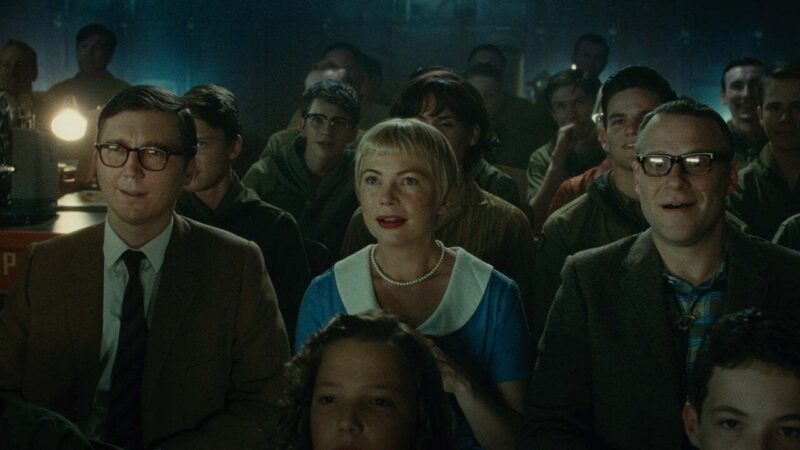
A recap of The Fabelmans‘s ending
After accepting a job at CBS to work on the television TV show Hogan’s Heroes, Sammy is confronted by the show’s co-creator Bernard Fein. Bernard is worried about Sammy, who seems to be out of place in the television setting. “Aren’t you passionate about movies?” he asks, to which Sammy replies that he’s willing to work from the ground up to make it in Hollywood. Noticing Sammy’s work ethic and enthusiasm, he invites Sammy to meet the “greatest director who ever lived.” Little does Sammy know this man is John Ford.
In Ford’s office, Ford points to a picture and asks Sammy to tell him what he sees. Sammy begins to describe the people and objects in the picture before Ford stops him and demands, “Where is the horizon?” It’s at the bottom of the frame, Sammy says. Ford then points to another picture and repeats the process. As Sammy describes the picture once again, Ford stops him and again demands, “Where is the horizon?” It’s at the top of the picture.
That’s when Ford gives Sammy the only piece of advice he’ll give that day. When you frame a shot, the horizon belongs at the top of the frame or the bottom of the frame—but never in the middle of the frame.
Sammy takes his leave and steps outside. He looks around at the Hollywood lot and begins to walk away. As he walks, the horizon is positioned in the center of the frame. Then, suddenly, the camera points upwards, moving the horizon to the bottom of the frame.
The meaning of The Fabelmans‘s ending
To some, this visual adjustment at the end of The Fabelmans might seem like a joke. Like it came out of nowhere and has no place in this movie. But The Fabelmans is very much a metafilm that, for its entirety, has very much carried the same self-awareness. It all depends on how you’ve watched the movie.
So what is a metafilm? Essentially, a metafilm is a movie within a movie. Or a movie that makes the audience aware it is watching a movie. And our main path to understanding The Fabelmans as a metafilm is none other than the director himself: Steven Spielberg. It’s well known that the movie depicts Spielberg’s childhood. That’s been part of the film’s marketing during awards season, as the filmmakers and producers are hoping to capitalize on the story of Hollywood’s greatest director of the past several decades. For the script, Spielberg would detail key moments of his life, and Kushner, co-writer of the film alongside Spielberg, would inquire about specific parts. This is how the screenplay was born.
But that’s only half the story. It’s one thing to write down the story of your life. It’s another trip entirely to visually capture the pivotal moments that would define you as the man, as the artist you’d become. This is where The Fabelmans goes from autobiography to metafilm—this is what lends key insight into that final shot.
Even if you didn’t know The Fabelmans was based on Spielberg’s life, there are plenty of clues throughout that the director is very much part of this movie. After Sammy watches The Greatest Show on Earth in theaters, he becomes obsessed with recreating the movie’s momentous crash with a toy train set. When the toy trains crash, we aren’t watching the screen from afar like Sammy did in the theater—we are at Sammy’s level, in line with the trains as they barrel down the tracks. We are seeing what he sees. We are gaining insight into a soon-to-be-filmmaker’s cinematic vision.
The visual examples continues as Sammy works his camera. We are constantly looking through the camera at what Sammy sees. When he coaches an actor how to perform a scene, we then see that scene play out in its entirety. We are cued into how Sammy edits together certain scenes. We watch him discover Mitzi and Bennie’s secret affair through the camp footage. Over and over, we are given crucial insight into how his filmic eye functions. In essence, we are watching from Spielberg’s childhood from his own point of view.
The most penetrating moment happens as Mitzi reveals she’s been having an affair with Bennie. Her daughters are crying and screaming at her while Sammy, who already knew about the affair, watches from the stairwell. Then, suddenly, Sammy envisions himself in the mirror of the room, rolling a camera and capturing the footage of the moment. He gazes at this scene in shock, completely arrested by the fact that all he can do is think about how he’d film such an arresting, pivotal moment in his life.
But here’s the thing: that moment in the mirror didn’t actually happen. Maybe, yes, Spielberg did think about how he’d film that moment as a teenager while his family was fighting. But there’s a difference between a literal representation of something and a symbolic representation. And what we see in that moment is a cinematic representation of Spielberg’s essence at that time. We don’t see Sammy in that mirror—we see the director in that mirror. We see how Spielberg felt at the time, how filmmaking was part of his very being, how storytelling would become his way of dealing with life’s greatest pleasures and grievances.
This is how you can think of the entire film. Yes, the characters of this movie represent real people from Spielberg’s life. And yes, the events of this movie reflect real situations in which Spielberg was involved. But we also have to remember that we’re watching a movie. This isn’t a documentary, but a man’s recollection of his own life. Every movie does this, but not every movie is about a filmmaker who’s actively making films in the movie. Thus, each and every moment of The Fabelmans comes packed with a filmic twist, with an artistic vision. We aren’t watching Spielberg himself, but Spielberg reflecting on his existence and how he came to be.
With this attitude, the ending of the movie makes complete sense. If we accept that we are watching Spielberg in real time as he reflects on his childhood, then each and every moment of the film exists in the same vein as that final moment when the camera tilts upwards. Sammy is so concerned with the objects in the pictures that he forgets to think about the horizon, the environment, the framing—the destination. Sammy is so fixated on the mundane elements of Ford’s pictures that he overlooks a key philosophical component of filmmaking: it doesn’t matter what people are doing in the frame—what matters is how you frame what those people are doing.
And with that lesson in his back pocket, Spielberg decides to tilt the camera upwards. It’s an optimistic ending that repositions the horizon at the bottom of the frame, opening up the world to Sammy as he sets out to become a director. Through the ups and downs of Spielberg’s life, film has been a guiding light that taught him how to visualize stories. Stories that speak to the universal truths of life and help others through troubling times. Stories that reveal the depths of humanity and provide a promising path to redemption, to enlightenment, to purification. By being so vulnerable and making himself such a part of the movie, Spielberg doesn’t just make a movie for himself, but for anybody searching for catharsis and inspiration.
The themes and meaning of The Fabelmans
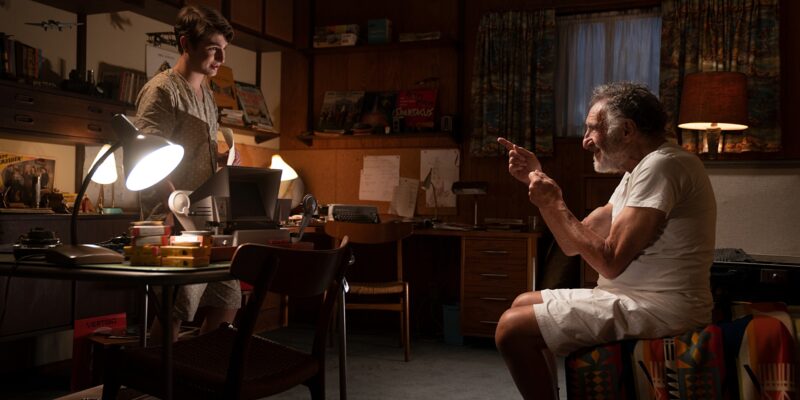
Art as a means of self-evaluation
Sigmund Freud, the famous founder of psychoanalysis, wrote a book in 1899 entitled The Interpretation of Dreams, in which he developed the “dream-work theory.” Essentially, this theory distrusts narrative as a form of censorship in dreams: the structure and events of your dream don’t tell the real story. Of much greater value are the images and symbols that populate your dreams, as they reveal your underlying hopes, ambitions, fears, deficiencies.
You can view any piece of art in this light. The shapes and contours of a person’s body in a painting are a reflection of how that painter observed his subjects, and provide insight into how that painter views the world. Take, for instance, Ilya Repin’s painting Ivan the Terrible and His Son Ivan. We know what the picture literally depicts: Russian tsar Ivan the Terrible holds his dead son after hitting him in a fit of anger. But as we stare at the painting, the subtleties reveal the true emotion and meaning of the image. The painting doesn’t depict violence, but its tragic aftermath: the father sits in anguish and cries as he holds his son with clear regret and anguish. In effect, the painting becomes a timeless representation of physical abuse between parent and child, of moral rejection in moments of exasperation, of inescapable remorse and despair that cannot be reversed.
The same goes for the art of storytelling in film. The plot is only the blueprint for a movie’s true meaning. The situations and characters are nothing more than vehicles for ideas expressed and explored by the artist.
Since The Fabelmans is based on Spielberg’s childhood, we can think of the film not as autobiography, but as a means of self-evaluation. The situations we see on screen are not literal representations of Spielberg’s life, as the characters’ names have been changed, as the people of Spielberg’s life are played by actors, as the situations have been altered and dramatized for the sake of entertainment. Instead, the characters and imagery and mise-en-scene of the film serve as symbols of Spielberg’s life as he looks back on his youth.
In this sense, The Fabelmans can be defined as a metafilm—a mode of filmmaking that informs the audience they are watching a movie. We aren’t watching a literal depiction of Spielberg’s life, but a dream-like interpretation of his own life. Even when situations reflect actual events from his life or when characters represent actual people, those specific events and people have been carefully chosen, arranged, and edited together to represent something deeper. You can view the movie as a jigsaw puzzle Spielberg puts together as he examines himself. Altogether, The Fabelmans becomes a representation of his current ideologies and how his youth shaped him and his love of filmmaking.
The power of the camera
As Sammy becomes more and more capable as a director, he increasingly discovers the power of his movie camera. At first, his filmic understanding is limited to entertainment. Before long, he realizes the camera’s ability to expose the humanity of a situation. And by the end of the movie, the camera becomes a timeless means of capturing the tone and tenor of life itself.
When Sammy watches the train crash in Cecil B. DeMille’s The Greatest Show on Earth, he is absolutely entranced by the camera’s ability to capture the surreal, the out-of-the-ordinary, the fantastic. At first, that’s all he wants to do with his train set, with his camera: to create something extraordinary you can watch over and over. To him, movies represent an escape from life. And he’s eager to share his art with the world to invoke a similar feeling in others.
Then Sammy begins to understand the deeper implications of the camera. When he films a battle scene with his Boy Scout troop, he coaches one of his actors to feel remorse for his fallen soldiers. After a long talk, the boy becomes crestfallen at the thought of losing his friends. As Sammy films the scene, the boy sinks into a temporary depression that goes beyond acting—Sammy has triggered a deeper existential confrontation in this boy’s being; a buried, intrinsic fear regarding death and loss. It’s in this moment that Sammy understands the camera’s ability to reveal the deeper humanities of a story.
Eventually, that realization extends to moments from his own life. Take the footage he films for his family’s camping trip. To the naked eye, the relationship between Mitzi and Bennie is completely innocent, their interactions innocuous. But after carefully observing the outskirts of the frame, by slowing down certain moments, by carefully editing together a string of events, Sammy is able to expose the deeper implications of their relationship. Thus, the camera becomes a tool for exposing truths we cannot see with the naked eye.
The final shot of the film serves as the catharsis for this thematic journey. John Ford tells Sammy to never position the horizon in the middle of the frame. So, as Sammy leaves Ford’s office and steps outside, the camera literally repositions itself so the horizon is situation at the bottom of the screen. This becomes Spielberg’s way of opening the world up to Sammy through the very camera he’s used to detail Sammy’s life.
And since Sammy is a fictionalized version of Spielberg’s own life, this becomes a meta-moment for Spielberg himself. Every lesson Sammy has learned with his camera, from his humble beginnings to his existential understandings of humanity, has built to this moment. The camera has allowed Sammy to be more observant of the world and the people around him. He knows the immense responsibility he holds as a filmmaker. And with that understanding, he’s ready to go out and film great movies that can make the world a better place.
Why is the movie called The Fabelmans?
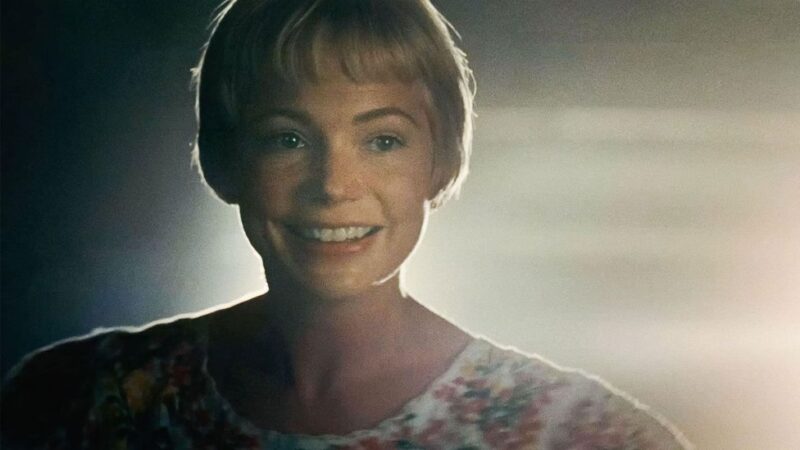
The answer to this question might seem simple, as Kushner himself provides an answer. But there’s actually more to it than meets the eye. Because while the words “fabel” and “fable” pertain to storytelling, their definitions are very different.
First, Kushner. In this story from The Hollywood Reporter, Kushner, who has worked on several screenplays with Spielberg, elaborated on writing The Fabelmans. After all, the movie is based on Spielberg’s life. So why not just call it The Spielbergs? Kushner’s response:
“Spielberg means play-mountain; ‘spieler’ is an actor in Yiddish, and a ‘spiel’ can be speech or can be a play. I’ve always thought how wild that this guy is this great once-in-a-century storyteller who would be called Spielberg, play-mountain. I wanted to have some of that meaning, and I’ve always liked the German word ‘fabel,’ which means fable. And because the movie is autobiographical for Steven but it isn’t an autobiography, it’s not a documentary, so there’s a fictional element as well. So I thought that ‘Fabelman’ was a nod to that.”
This is where it gets tricky. Because Kushner is not wrong: “fabel” literally translates to “fable” from German to English. So in this light, Kushner’s insight makes sense—the movie’s title is literally a play on that translation. But “fabel” is also an actual word with a completely different definition. Which triggers a very interesting conversation about the themes and meaning of The Fabelmans and art of storytelling in general.
Fable is a literary genre that most of us are familiar with. A fable a short form of narrative, written in prose or verse, populated with animals, plants, and inanimate objects that can speak and think like humans. At the heart of any fable is a moral lesson. The most famous collection of fables is Aesop’s Fables, which gave us stories like The Hare and the Tortoise. In that fable’s case, the lesson is “slow and steady wins the race.”
But a fabel is something different. A fabel is a critical analysis of the plot of a play that consists of three interrelated parts: the social interactions between characters, the structure of the plot, and the attitudes embodied and articulated by the play. Essentially, you could say that Film Colossus specializes in fabels.
The Fabelmans is most definitely a story—but it is definitely not a fable, by definition. Fables are short and feature non-human creatures. But we can think of The Fabelmans as a fabel, as the film is Spielberg’s reflection of his own life. He is looking back on his youth and observing the social interactions between people, the structure and shape of his formative years, the ideologies born from his experiences.
The Fabelmans isn’t strictly autobiographical, as the characters and situations have been altered. Instead, what we see is Spielberg’s observation of his childhood. The characters, the structure, the attitudes that are born from The Fabelmans are all representative of Spielberg’s vision as an artist; they are opportunities for Spielberg to reckon with the joys and pains of his youthful years and understand how they shaped him. By breaking select portions of his life into this story, he’s presenting a version of his life that helps him find catharsis as a director, as an artist, as a human being.
Important motifs in The Fabelmans
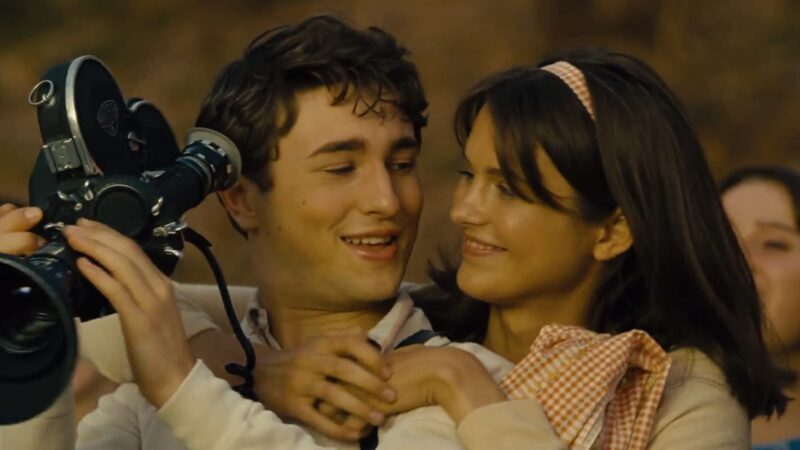
Cameras
This one is obvious—but there’s so much to unpack when it comes to the use and role of cameras in The Fabelmans. As we discussed in the themes and ending sections, The Fabelmans is very much a metafilm. Which means we the audience are made aware that we’re watching a movie. Spielberg is behind the camera, and the movie is about his own life: we are actively watching Spielberg as he reviews his childhood and how he became a filmmaker.
So anytime a camera is used, that information becomes a driving force of the film’s aesthetic. Sammy isn’t just using a camera to make movies—he’s using the camera to survey his surroundings and track his personal growth. The camera becomes an outlet to so many lessons (such as when Sammy coaches the Boy Scout to be sad about losing his friends in battle) and discoveries (such as when he finds out about Mitzi and Bennie’s affair) that would go on the shape him and the man (and artist) he’d eventually become.
Creativity
Burt is enthusiastic about Sammy making movies, but only as a hobby. As a man of science, Burt believes that a “standard” education is the best path for Sammy, and that filmmaking isn’t a legitimate path for a career.
Mitzi is the opposite. As a musician, she is a creative. She believes in creating something with your hands, in using the right side of your brain to grow and develop. She pushes Sammy to consider filmmaking more than a hobby, to allow his passions to flourish and guide him.
Burt and Mitzi’s eventual break-up marks symbolic tension for Sammy. Spielberg knows his younger self could very well have abandoned his passions and followed in his father’s footsteps. So as Spielberg tracks Sammy’s journey to becoming a filmmaker, he’s sure to mark important conversations and moments where Sammy had to reckon with which path he’d take. These are pivotal moments in the movie that coincide with Sammy’s development and growth.
Judaism
Sammy’s Jewish heritage is part of several crucial dynamics and scenes throughout The Fabelmans. In all cases, Judaism shares an important relationship with Sammy’s growth as a human and as a filmmaker.
It starts with Hanukkah, when Sammy receives an additional piece of a train set on each night of the holiday. He’s desperate to acquire the set after his viewing of The Greatest Show on Earth, eager to recreate the train crash scene from the movie. Religion becomes a means of realizing his desires and triggering a lifelong passion.
Then there’s Sammy’s conversation with his Jewish uncle Boris, who cautions Sammy about pursuing his passion for filmmaking. “Art will give you crowns in heaven and laurels on earth, but also, it’ll tear your heart out and leave you lonely,” Boris says, directly speaking of religion and the afterlife. In addition, Boris says, “Family, art—it will tear you in two.” These prove to be prescient words, as Sammy’s father views filmmaking as nothing more than a hobby and pushes Sammy to receive a proper education. Plus, Sammy’s resentment over his mother’s affair causes him, in a Freudian move, to temporarily give up filmmaking, as Mitzi is a creative.
In the midst of his filmmaking hiatus, anti-Semitism becomes a powerful force in the film. Before moving to California, Sammy doesn’t encounter much prejudice or racism. But in his new California school, he’s suddenly forced to discuss and defend his Jewish heritage. And the only way he’s able to reconcile contentious relationships with Logan, the high school bully who makes fun of Sammy’s heritage, is by making a movie that highlight’s Logan’s accomplishments. It’s when Sammy does this that he rediscovers his passion for filmmaking.
Questions & answers about The Fabelmans
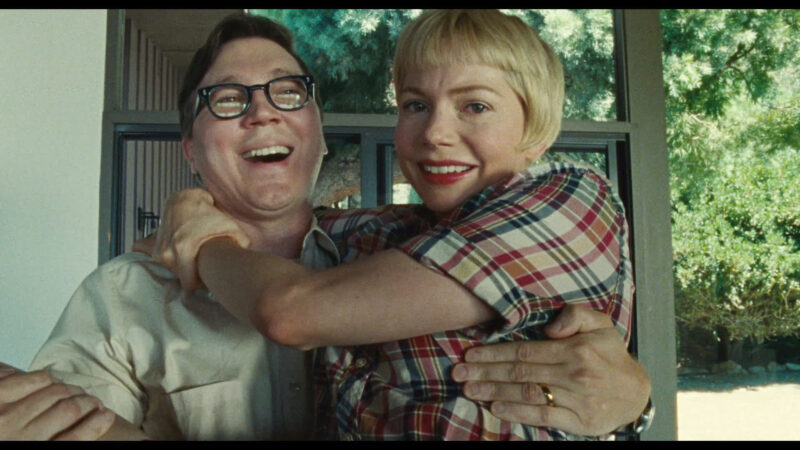
How autobiographical is The Fabelmans?
This is a tough question to answer because, as we discussed in the themes and ending sections, The Fabelmans is a metafilm. Meaning that the audience is made aware it is watching a movie. To an extent, we’re not watching a literal recreation of Spielberg’s life, but instead an artful interpretation of several moments from his life.
With that said, Spielberg himself has confirmed several things that happen in the movie are factual. For instance, his mother (her name was Leah in real life, not Mitzi) really did leave Sammy’s father for his best friend. And in an interview with New York Times film critic A.O. Scott, Spielberg revealed that he did indeed discover the affair from camping trip footage. Essentially, most of Sammy’s family drama appears to be accurate of Spielberg’s real life.
Perhaps the craziest confirmation from Spielberg was that the meeting with John Ford really did happen—exactly as we see it in the film. “Word for word,” said Spielberg. “Nothing more, nothing less.”
One major divergence the movie has from Spielberg’s real life is that he did not temporarily give up filmmaking because of his mother—it happened after a viewing of Lawrence of Arabia. “When the film was over, I wanted to not be a director anymore because the bar was too high,” Spielberg said. “…I had such a profound reaction to the filmmaking, and I went back and saw the film a week later. I saw the film a week after that, and I saw the film a week after that, and I realized that there was no going back. This was going to be what I was going to do or I was going to die trying.”
Now it’s your turn
Have more unanswered questions about The Fabelmans? Are there themes or motifs we missed? Is there more to explain about the ending? Please post your questions and thoughts in the comments section! We’ll do our best to address every one of them. If we like what you have to say, you could become part of our movie guide!

